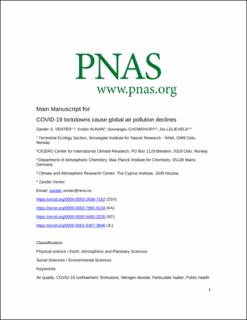COVID-19 lockdowns cause global air pollution declines
Peer reviewed, Journal article
Accepted version

Åpne
Permanent lenke
https://hdl.handle.net/11250/2671112Utgivelsesdato
2020Metadata
Vis full innførselSamlinger
- Publikasjoner fra CRIStin - NINA [2364]
- Scientific publications [1392]
Originalversjon
10.1073/pnas.2006853117Sammendrag
The lockdown response to coronavirus disease 2019 (COVID-19) has caused an unprecedented reduction in global economic and transport activity. We test the hypothesis that this has reduced tropospheric and ground-level air pollution concentrations, using satellite data and a network of >10,000 air quality stations. After accounting for the effects of meteorological variability, we find declines in the population-weighted concentration of ground-level nitrogen dioxide (NO2: 60% with 95% CI 48 to 72%), and fine particulate matter (PM2.5: 31%; 95% CI: 17 to 45%), with marginal increases in ozone (O3: 4%; 95% CI: −2 to 10%) in 34 countries during lockdown dates up until 15 May. Except for ozone, satellite measurements of the troposphere indicate much smaller reductions, highlighting the spatial variability of pollutant anomalies attributable to complex NOx chemistry and long-distance transport of fine particulate matter with a diameter less than 2.5 μm (PM2.5). By leveraging Google and Apple mobility data, we find empirical evidence for a link between global vehicle transportation declines and the reduction of ambient NO2 exposure. While the state of global lockdown is not sustainable, these findings allude to the potential for mitigating public health risk by reducing “business as usual” air pollutant emissions from economic activities. Explore trends here: https:// nina.earthengine.app/view/lockdown-pollution. air quality | COVID-19 confinement | emissions | nitrogen dioxide |particulate matter